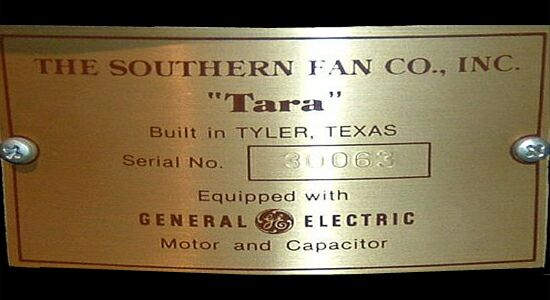|
|
|
|
|
Unique and Distinctive Characteristics of Tara Fans
Bell Canopy: obviously this term would be used to describe a canopy shaped like a bell, but it is also used to include any canopy that screws, with a collar and set screw, to the down rod as opposed to being attached to the mounting bracket. In the case of the Tara canopy it is actually shaped like a bell and much larger than most canopies. The collar is small and rolled brass.
Motor Housing, Vents: the Tara motor housing was a direct copy of the pre-1980 Casablanca Zephyr and the motor housing is almost exactly the same. As opposed to many less expensive import fans, the Tara (and Casablanca) motor housing is 3 piece, with cast top and bottom plates and a separate sideband. The unique thing about the Tara motor housing is the vent holes, which are shaped like an elongated letter 'U'. The only other fan known with these vent holes is the belt-drive Toastmaster. Notice, on the Tara, the reverse switch mounted in one of the vent holes.
Switch Housing: The Tara switch housing was made much smaller than most fans, this was designed to look less clumsy when a light kit was mounted. The switch housing cap was made decorative and tapered and had a small letter 'T' embossed in the center.
Variable Speed Control w/ Wooden Knob: one of the most noticeable things about the Tara fan is the giant wooden variable speed knob. Unlike almost every other variable speed fan, the Tara does not have a pull chain control of any kind; the fan is operated solely by the variable speed knob. The fans also came with the option to mount the variable speed control as a wall control, in which case a wooden plug (matching the knob) was provided to fill the hole in the switch housing.
Blades and Blade Brackets: the Tara blade brackets are very unique, the only brackets even remotely close came from an antique Diehl ceiling fan. Supposedly the design idea came from the hinge on a very old gate in New Orleans. The blades are real wood and have 'arch-end' tips, reminiscent of many antique ceiling fans.
GE Motor with Flywheel: most quality/American-made ceiling fans since the late 70s used an 18 pole "stack"/ K55 type motor, usually made by Emerson or General Electric. These motors are quiet even when used with a variable speed control, and have a much higher manufacturing cost than imported spinner motors. Most fans with K55 motors employ a rubber flywheel which attaches the blade irons to the motor shaft, thereby isolating any vibration from the blades. The problem with many such fans, including the Tara, is that the rubber in earlier flywheels disintegrated very quickly, causing the blades to detach from the motor assembly. More info in the Flywheel Section. In many fans, the flywheel protrudes slightly from the motor housing and is therefore visible when the fan is assembled. This is another distinctive feature of the Tara.
"Tara" Nameplate: The nameplate is affixed to the sideband of the motor housing and is clearly visible when the fan is installed. The relabeled fans do not have this nameplate.
Finishes: Nowadays fans are available in every finish from pewter to gold. When the Tara was made finishes were a great deal more standard, however it was offered in a great deal of different combinations. You could mix and match different finishes with the motor housing, sideband and blade brackets, and blades. Ergo the more classic examples, such as the brown and brass fan, or you could choose, say, a chrome fan with black accents. As opposed to offering various models of fans, Southern Fan Co only offered the Tara, but in any combination you desired. They also offered an ornate version, seen in the Gallery.
Email
mtneuman@mailbag.com with any
comments or corrections.
|
|
|

